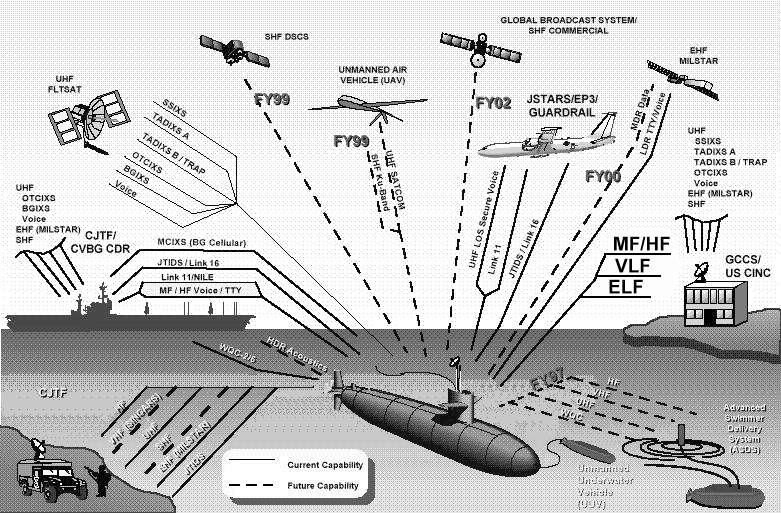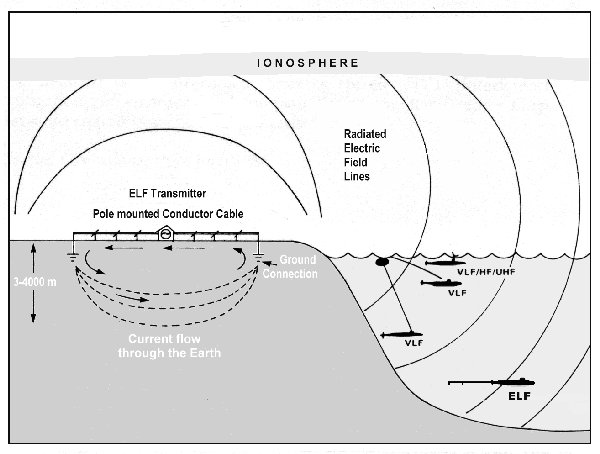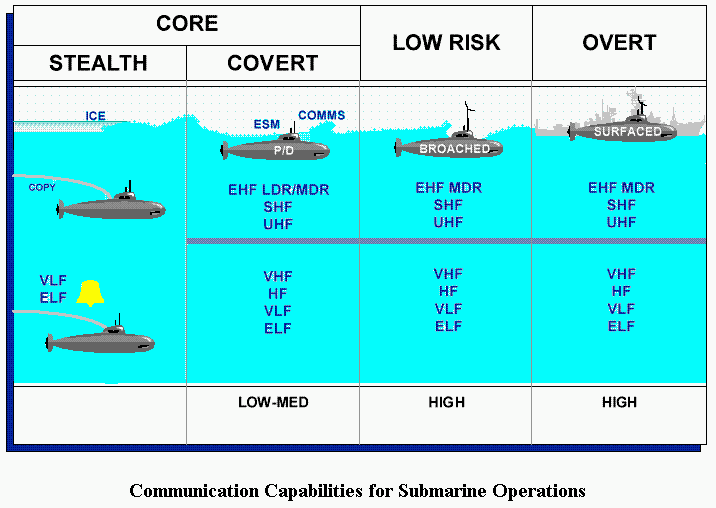how it worked ? RF signal in salty water ?
时间:04-06
整理:3721RD
点击:
dears
someone told me that no RF signal under the sea water since it is salty , is it true ?
so how submarine communicates and how it receives GPS signal
ELF [Extremely Low Frequency 30 Hz - 300 Hz 10,000 Km - 1,000 Km wavelength] - This is the only band that can penetrate hundreds of meters below the surface of the ocean. The US Navy transmits ELF messages using a huge antenna in Wisconsin and Michigan created by several miles of cable on towers in conjunction with the underlying bedrock. This band is used to send short coded "phonetic letter spelled out" (PLSO) messages to deeply submerged submarines that are trailing long antenna wires. The communication is only one way, therefore it is used primarily for prearranged signals or to direct the submarine to come closer to the surface for faster communications. Environmental factors do not have a strong influence on changing the signal and therefore it is quite reliable.
VLF [Very low frequency 3 kHz - 30 kHz 100 Km - 10 Km ] This band can penetrate several meters below seawater and can transmit much more information than ELF, therefore it is useful for submarine communications when the submarine cannot surface, but can come close to the surface. It can be affected by salinity gradients in the ocean, but these usually do not present problems for near-surface submarines. There are natural sources of VLF radiation, but in general, like ELF, it is not strongly influenced by changes in environmental conditions therefore it is useful for reliable global communications. The transmission antennas need to be large, therefore it is primarily used for one-way communications from shore-based command centers to surface ships and submarines. It can also be used to broadcast to several satellites at once, which can in turn relay messages to the surface. The Navy's VLF systems serve as a back-up for global communication use during hostilities when nuclear explosions may disrupt higher frequencies or satellites are destroyed by enemy actions. VLF is also used for aircraft and vessel navigation beacons and for transmitting standard frequencies and time signals.
HF [High frequency 3 MHz - 30 MHz 100 m - 10 m ] - The Navy makes extensive use of this band for communications. It is also used for long range ("over-the-horizon") radar. Due to the skywave transmission mode, HF radiation can travel great distances, sometimes to the other side of the earth. Due to its versatility and large coverage area, this is a very crowded band and the military can only use a few frequency regions scattered throughout this band. The most efficient transmissions require fairly large antennas, therefore it is most useful when at least one of the stations is on shore. The antenna size limits its use on aircraft. It cannot be used for satellite communications since it is reflected by the ionosphere. Many of the former uses of HF by the Navy are now being taken over by satellite communication systems. However, we expect that the Navy will continue to use HF for quite some time in the future. The primary drawback to HF use is that it is highly susceptible to changes in the ionosphere and therefore several frequencies must be available for use.
someone told me that no RF signal under the sea water since it is salty , is it true ?
so how submarine communicates and how it receives GPS signal
Submarines communicate on VLF 9- 15 KHZ.
Frank
Deep secret ? secure submarine communication on a quantum level
http://www.naval-technology.com/feat...-quantum-level
Communication with submarines
http://en.wikipedia.org/wiki/Communi...ith_submarines
RECEPTION OF SUBMARINE COMMUNICATION SYSTEMS
http://www.vlf.it/submarine/sbmarine.html
Submarine Communications
http://www.globalsecurity.org/milita...p/sub-comm.htm



ELF [Extremely Low Frequency 30 Hz - 300 Hz 10,000 Km - 1,000 Km wavelength] - This is the only band that can penetrate hundreds of meters below the surface of the ocean. The US Navy transmits ELF messages using a huge antenna in Wisconsin and Michigan created by several miles of cable on towers in conjunction with the underlying bedrock. This band is used to send short coded "phonetic letter spelled out" (PLSO) messages to deeply submerged submarines that are trailing long antenna wires. The communication is only one way, therefore it is used primarily for prearranged signals or to direct the submarine to come closer to the surface for faster communications. Environmental factors do not have a strong influence on changing the signal and therefore it is quite reliable.
VLF [Very low frequency 3 kHz - 30 kHz 100 Km - 10 Km ] This band can penetrate several meters below seawater and can transmit much more information than ELF, therefore it is useful for submarine communications when the submarine cannot surface, but can come close to the surface. It can be affected by salinity gradients in the ocean, but these usually do not present problems for near-surface submarines. There are natural sources of VLF radiation, but in general, like ELF, it is not strongly influenced by changes in environmental conditions therefore it is useful for reliable global communications. The transmission antennas need to be large, therefore it is primarily used for one-way communications from shore-based command centers to surface ships and submarines. It can also be used to broadcast to several satellites at once, which can in turn relay messages to the surface. The Navy's VLF systems serve as a back-up for global communication use during hostilities when nuclear explosions may disrupt higher frequencies or satellites are destroyed by enemy actions. VLF is also used for aircraft and vessel navigation beacons and for transmitting standard frequencies and time signals.
HF [High frequency 3 MHz - 30 MHz 100 m - 10 m ] - The Navy makes extensive use of this band for communications. It is also used for long range ("over-the-horizon") radar. Due to the skywave transmission mode, HF radiation can travel great distances, sometimes to the other side of the earth. Due to its versatility and large coverage area, this is a very crowded band and the military can only use a few frequency regions scattered throughout this band. The most efficient transmissions require fairly large antennas, therefore it is most useful when at least one of the stations is on shore. The antenna size limits its use on aircraft. It cannot be used for satellite communications since it is reflected by the ionosphere. Many of the former uses of HF by the Navy are now being taken over by satellite communication systems. However, we expect that the Navy will continue to use HF for quite some time in the future. The primary drawback to HF use is that it is highly susceptible to changes in the ionosphere and therefore several frequencies must be available for use.
